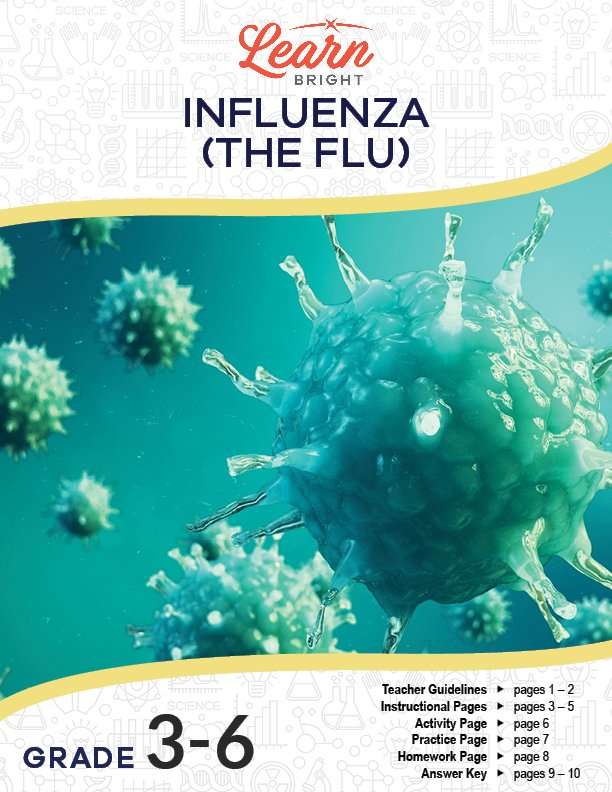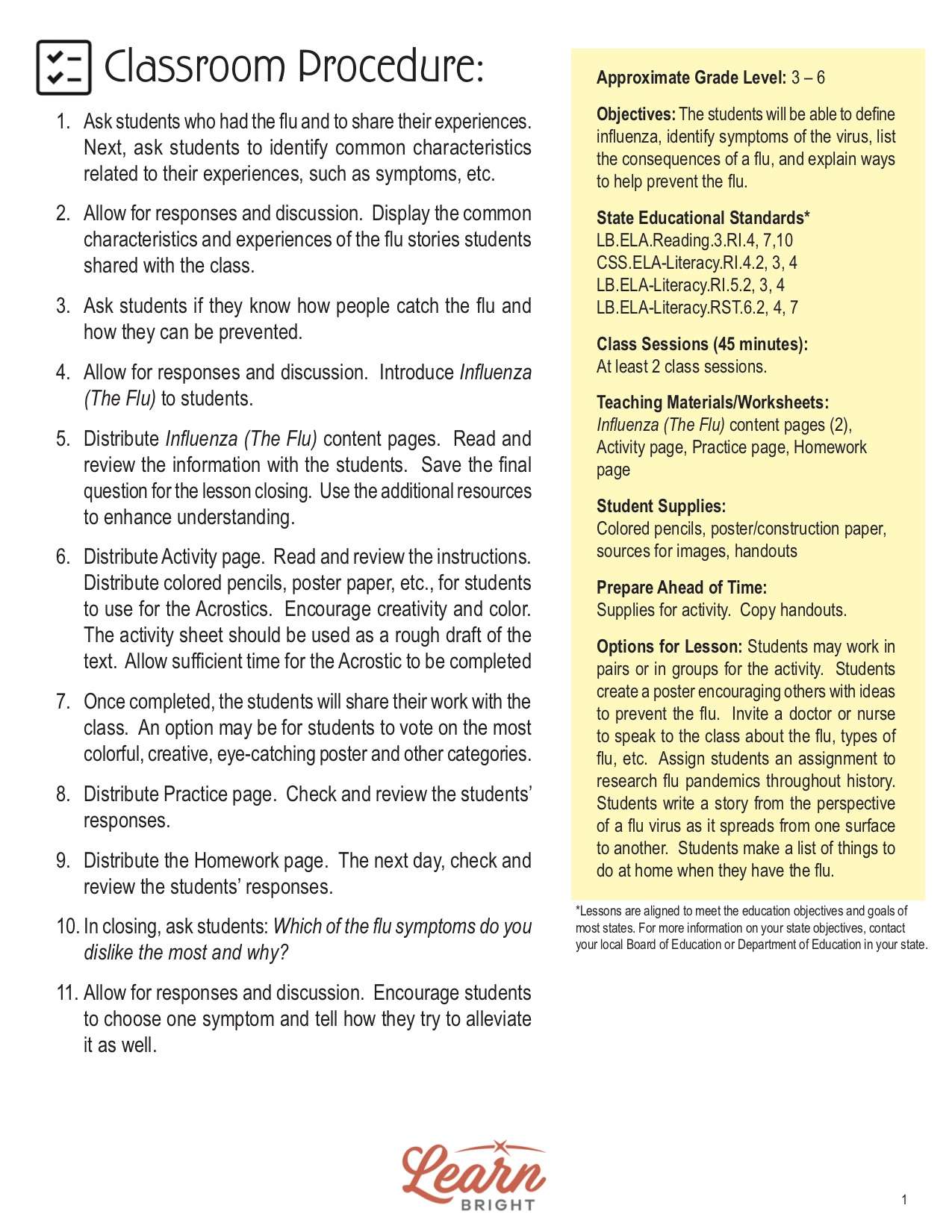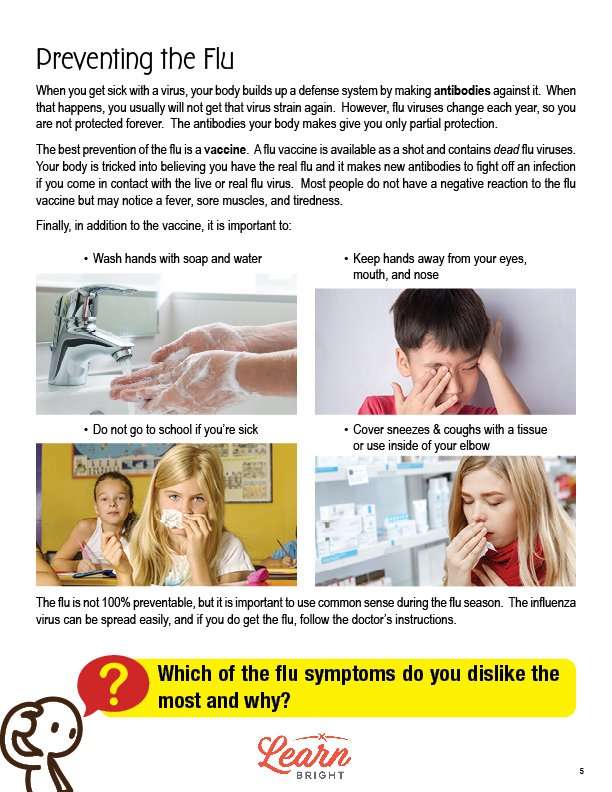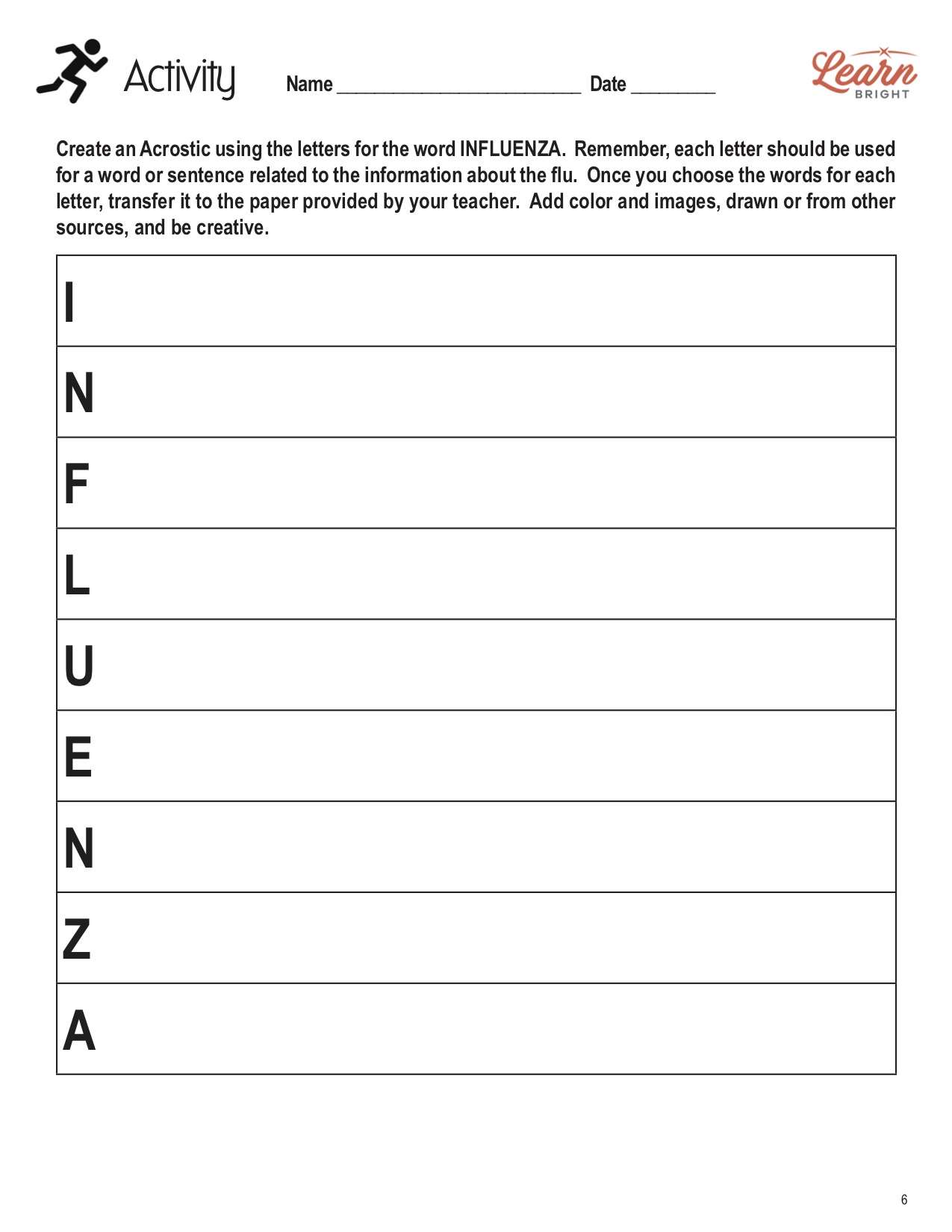Description
What our Influenza lesson plan includes
Lesson Objectives and Overview: Influenza teaches students some basic information about this virus. Students will learn about the symptoms of the flu, the consequences of having the flu, and ways to help prevent becoming infected with it. This lesson is for students in 3rd grade, 4th grade, 5th grade, and 6th grade.
Classroom Procedure
Every lesson plan provides you with a classroom procedure page that outlines a step-by-step guide to follow. You do not have to follow the guide exactly. The guide helps you organize the lesson and details when to hand out worksheets. It also lists information in the yellow box that you might find useful. You will find the lesson objectives, state standards, and number of class sessions the lesson should take to complete in this area. In addition, it describes the supplies you will need and what and how you need to prepare beforehand. For this lesson, the only other supplies you will need are the handouts, colored pencils, poster or construction paper, and various sources for images.
Options for Lesson
The classroom procedure page contains an “Options for Lesson” section that lists a number of suggestions for additional activities or other tasks to incorporate. One suggestion is to add an activity in which students create posters with ideas on how to prevent the flu that encourage others to be safe. Another idea is to invite a doctor or other medical professional to speak to the class about the different types of the flu. You could also have students research flu pandemics throughout history and present what they find to the class. Students could write stories from the perspective of a flu virus as it spreads from person to person. One more idea is to have students list things they can do at home when they have influenza.
Teacher Notes
This page provides an extra bit of information on what to expect from the lesson or guidance on how to go about it. The paragraph suggests you use a variety of sources from organizations like the CDC to educate students as much as possible on the topic. It also mentions that you could teach this lesson in conjunction with others about germs or other health-related topics. Use the blank lines on this page to write down ideas you have as you prepare the lesson for your class.
INFLUENZA LESSON PLAN CONTENT PAGES
The Influenza lesson plan has three pages of content. The lesson first describes the symptoms commonly present when someone contracts the flu, like fever, chills, and body aches. It explains that influenza is a virus, which is a microorganism that is so small that you can only see it with a powerful microscope. This virus affects the respiratory system.
The respiratory system consists of the nasal passages, larynx, trachea, bronchial tubes, and lungs. When it works properly, it allows us to breathe and exchange oxygen for carbon dioxide throughout the whole body. When it doesn’t work properly, it is most often due to the common cold. Other times, however, it might be the influenza virus.
There are two types of flu viruses, A and B. Influenza A is the type that is most common in humans. Scientists break it down into H and N subtypes, with 16 H subtypes and 9 N subtypes. They also name the strains according to origin, geographical location, strain number, and year of discovery. Nearly all flu pandemics in modern history came from influenza A.
How It Spreads
On the other hand, influenza A is less common, even though it can still cause outbreaks of seasonal flu. Scientists break down the virus into individual strains rather than subtypes. There is little difference between the A and B types apart from how they affect a person. Regardless of the type, the symptoms include high fever, cough, sore throat, stuffy or runny nose, muscle pain, and weakness.
Influenza is also contagious and can spread from person to person in various ways. One is through coughing or sneezing. When someone coughs or sneezes, droplets from a person’s mouth that contain the virus travel through the air. Other people can then breathe it in and become infected themselves. In addition, those droplets can land on surfaces, and the virus can remain on those surfaces for some time. If someone touches that surface later and then touch their own mouth, nose, or eyes, they can contract the flu themselves.
About every 10 years, the flu virus goes through major changes, and many people end up with severe cases. Large-scale outbreaks are epidemics, and they become pandemics when they spread worldwide. For example, the swine flu outbreak in 2009 and 2010 was an epidemic and later a pandemic.
Getting the Flu
Students will discover some facts about how the flu infects and affects the body. When first exposed, the virus endures an incubation period. First, the virus tries to invade a cell in the respiratory system. Once is succeeds, it multiplies rapidly and clones itself many times while damaging the host cell. The newly-made viruses leave the damaged cell and start to invade other healthy cells.
The process repeats and the virus spreads throughout the body. The incubation period can last two or more days, and then a variety of symptoms start to appear. A person can spread the virus during the incubation period and then around five to seven days after they first get symptoms. In the United States, flu season usually happens between October and May.
People of all ages can get the flu, but kids are the ones who tend to get the flu most often. Generally, it’s not serious when you get a flu. However, older adults, young children, and people with medical conditions often become more seriously ill. In some cases, a strain of the flu can be much more severe and can even cause death.
The lesson explains that people who get the flu should stay home from work or school. They should rest and drink a lot of liquids that do not contain caffeine. Sometimes certain medications can help reduce the fever and aches, but not aspirin, which can make symptoms worse. Antibiotics likewise do not work on the virus or help people get better.
How to Prevent the Flu
Students will learn that if they do get sick with the flu, their body will build up a defense system by making antibodies against it. When that happens, they will usually not get that same virus strain again. However, because flu viruses change each year, we can’t stay protected forever. Antibodies, then, only provide partial protection.
The best prevention against the flu is a vaccine. A vaccine contains “dead” flu viruses designed to trick the body into believing a person actually has the real flu. The body then creates antibodies to fight off an infection if the person ends up coming into contact with the live strain. Most people do not react negatively to the flu vaccine, but other may notice a fever, sore muscles, and fatigue.
Of course, there are other ways to keep from getting sick with influenza. The lesson describes four specific suggestions. Washing your hands with soap and water is one of the most important. Similarly, you should refrain from touching your eyes, mouth, and nose. Cover sneezes and coughs with a tissue or the inside of your elbow. If you do get sick, stay home from school.
Key Terms
Here is a list of the vocabulary words students will learn in this lesson plan:
- Influenza (flu)—a virus that affects the respiratory system
- Pandemic—an outbreak of a disease or illness that spreads worldwide
- Epidemic—a large-scale outbreak of a disease or illness
- Incubation period—a period in which the flu virus invades a cell and multiplies many times before invading other cells
- Vaccine—a substance containing “dead” viruses that trick the body into creating antibodies to fight off the live version of a virus
INFLUENZA LESSON PLAN WORKSHEETS
The Influenza lesson plan includes three worksheets: an activity worksheet, a practice worksheet, and a homework assignment. Each one will help solidify students’ grasp of the lesson material and help them demonstrate what they learned. Use the guide on the classroom procedure page to determine when to hand out each worksheet to your students.
ACROSTIC POEM ACTIVITY
Students must create an acrostic poem using the letters from the word “influenza.” They must write a word or statement that begins with each letter in the word. They will add color and images that they either draw or find using other sources.
TRUE OR FALSE PRACTICE WORKSHEET
The practice worksheet is divided into three sections. For the first part, students must answer whether each of 10 statements is true (T) or false (F). The next part requires them to write the number of each false statement and rewrite it to make it true. The final section requires them to decide whether each fact matches Influenza A (A) or Influenza B (B).
INFLUENZA HOMEWORK ASSIGNMENT
There are two sections of the homework worksheet. The first section requires students to answer 10 questions related to the virus. The second section requires them to answer eight questions using yes or no.
Worksheet Answer Keys
The final pages of the document are answer keys for the practice and homework worksheets. The correct responses are in red to make it easy to compare them to students’ answers. For the most part, students’ work should match the answer keys, but there may be some variation on certain questions because of the nature of those questions. If you choose to administer the lesson pages to your students via PDF, you will need to save a new file that omits these pages. Otherwise, you can simply print out the applicable pages and keep these as reference for yourself when grading assignments.









